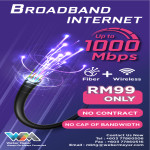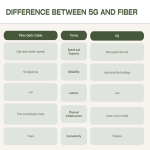
Broadband Vs WiFi
"Dive into the intricacies of internet connectivity: Broadband, the wired data lifeline, and Wi-Fi, the wireless bridge. Understand their roles, from delivering high-capacity data to seamless device connections, while considering the nuances of speed differentials."

Fiber Internet vs Satellite Internet
Fiber internet and satellite internet are two distinct types of broadband services that offer contrasting approaches to delivering data to users. Here, we explore the primary differences between the two: **Speed:** One of the most notable distinctions between fiber and satellite internet lies in their speed capabilities. Fiber internet boasts impressive speeds, reaching up to 1 Gbps. This is made possible because it transmits data through fiber optic connections using light pulses, a highly efficient and reliable method. On the other hand, satellite internet generally lags behind in terms of speed, offering a range from 12 Mbps to 100 Mbps. The reliance on radio waves to send and receive data from orbiting satellites can introduce delays or latency issues. **Availability:** Satellite internet holds a significant advantage in terms of availability, as it can be accessed almost anywhere on Earth. This is possible due to the coverage provided by satellites in geostationary orbit, which can span vast distances like entire continents or oceans. Conversely, fiber internet requires a physical connection to a fiber optic network, and while it has been expanding its reach, there are still regions, especially rural or distant areas, where it may not be accessible. **Reliability:** When it comes to reliability, fiber internet tends to hold the upper hand. Its infrastructure, often buried underground or mounted on utility poles, is better shielded from external factors such as weather, interference, or congestion. In contrast, satellite internet is more susceptible to environmental disruptions like rain, snow, wind, or cloud cover, which can interfere with the signal and lead to outages or delays. Additionally, network congestion can impact satellite internet, particularly when numerous users share the same bandwidth. **Cost:** Cost considerations also play a role in choosing between fiber and satellite internet. Satellite internet tends to be more expensive, especially for high-speed or unlimited plans, and users may also need to bear installation, equipment, and maintenance costs for satellite dishes and modems. Fiber internet, depending on the provider and plan, may be either less expensive or comparable in price. It may also offer better value for money with faster speeds and lower latency. In conclusion, while satellite internet provides wider coverage and is a viable option for remote locations, fiber internet shines in terms of speed, reliability, and potential cost savings. As the availability of fiber internet continues to expand, more users are finding it to be an attractive and efficient choice for their broadband needs.
Fiber Optic cable vs Ethernet Cable
"**Fiber Optic Cables vs. Ethernet Cables: A Networking Showdown** When it comes to data transmission in networking applications, two heavyweights go head-to-head: fiber optic cables and Ethernet cables. Each employs distinct technologies, offering unique advantages and limitations. Let's dive into the battle of these titans to understand their differences and find out which one reigns supreme for various networking needs. **1. Transmission Technology:** Fiber optic cables utilize pulses of light to transmit data through thin strands of glass or plastic called optical fibers. On the other hand, Ethernet cables, also known as twisted-pair cables, transmit data using electrical signals through copper wires twisted together. **2. Speed and Bandwidth:** Fiber optics flex their muscles in this arena, offering lightning-fast data transfer rates and expansive bandwidth. With speeds ranging from hundreds of megabits per second to several gigabits per second and beyond, fiber optics outpace traditional Ethernet cables. While Ethernet cables have evolved to handle speeds up to 10 Gbps, they still generally lag behind the potential of fiber optics. **3. Distance:** Here, fiber optic cables exhibit their superiority once again. They can transmit data over much longer distances without signal degradation. Single-mode fiber optic cables can span tens of kilometers without the need for signal repeaters. Ethernet cables, on the other hand, have distance limitations, with Cat5e and Cat6 cables handling up to 100 meters before experiencing signal loss. **4. Interference and EMI Immunity:** In the battle against electromagnetic interference (EMI), fiber optic cables emerge as champions. Their use of light signals makes them immune to EMI, making them ideal for environments with high electromagnetic interference. Ethernet cables, especially the unshielded variety, are more susceptible to EMI, leading to potential performance issues in noisy environments. **5. Installation and Flexibility:** Here, Ethernet cables gain an edge. Their installation is simpler, requiring no specialized expertise. These widely-used cables are known for their flexibility and durability compared to fiber optics, which are relatively fragile and require careful handling during installation. **6. Cost:** Finally, in the realm of cost-effectiveness, Ethernet cables have the upper hand. Historically, fiber optic cables have been more expensive due to the technology involved and the cost of specialized components. Ethernet cables, however, remain affordable and accessible, particularly for shorter distances. In conclusion, the choice between fiber optic cables and Ethernet cables depends on the specific requirements of the network and the budget available. For high-speed, long-distance, and interference-prone networking environments, fiber optics reign supreme. On the other hand, Ethernet cables are the go-to solution for most everyday networking needs, offering affordability and ease of installation." (Note: The above excerpt is a generated text and may not represent an actual published article. It is intended to showcase a comparison between fiber optic cables and Ethernet cables for illustrative purposes.)

Revolutionizing Internet Speeds in Malaysia
Discover Weber Meyer's Lightning-Fast 1000Mbps Connection




